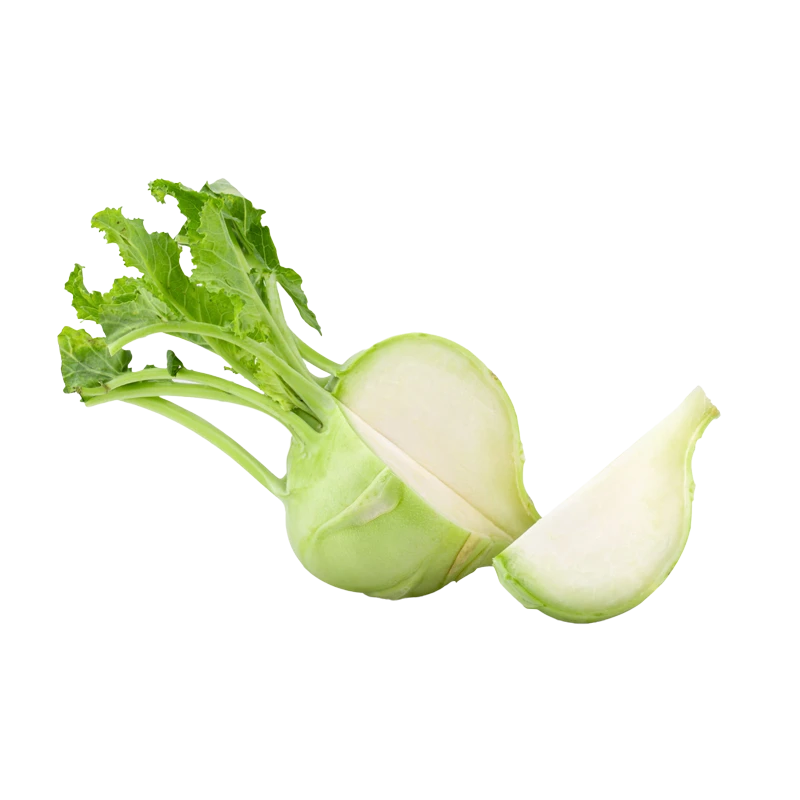Kohlrabi — Nutrients, Health Benefits, And Shopping Tips

Written by Listonic Team
Last update on September 4, 2024
Nutrition facts
Nutrition facts
Amount per 100 g
Calories
🔥 27 kcal
| Nutrition per: 100 g | Value | % Daily Value* |
|---|---|---|
| Carbs | 6 g | 2.18% |
| Fiber | 4 g | 14.29% |
| Sugars | 3 g | 6% |
| Glycemic Index | 20 | - |
| Protein | 2 g | 4% |
| Sodium | 20 mg | 0.87% |
| Total Fat | 0 g | - |
*The % of Daily Value (DV) tells you how much a nutrient in a serving of food contributes to a daily diet. 2,000 calories a day is used for general nutrition advice.
27
🍏 Low-Calorie Foods
20
🟢 Low Glycemic Index
Did you know?
Health benefits
- Rich in vitamins and minerals such as Vitamin C, Vitamin B6, and potassium, which support overall health and well-being.
- High in fiber, promoting digestive health, regular bowel movements, and a healthy gut microbiome.
- Contains antioxidants which help protect the body from free radicals and reduce inflammation.
- Low in calories, making it a nutritious option for weight management and overall health.
Health risks
- Potential for digestive discomfort such as bloating or gas when consumed in large quantities, particularly for individuals sensitive to high-fiber foods.
- Risk of thyroid function disruption in individuals with thyroid issues, as kohlrabi contains goitrogens, compounds that can interfere with thyroid hormone production when consumed in very large amounts.
- Potential for pesticide residue on conventionally grown kohlrabi, which can pose health risks if not properly washed or sourced from organic suppliers.
- Potential allergic reactions in sensitive individuals, causing symptoms like itching, swelling, or difficulty breathing, though this is rare.
How to choose kohlrabi
Kohlrabi should have a solid, round shape with a vibrant green or purple skin, depending on the variety. The flesh should be crisp and moist when cut into.
Steer clear of kohlrabi that feels soft or has blemishes, which are signs of age or damage. Good quality kohlrabi will taste mild and slightly sweet, perfect for eating raw or cooked.

How to store kohlrabi
Kohlrabi should be stored in the refrigerator's crisper drawer. Keep it in a plastic bag to maintain its crisp texture. Properly stored, kohlrabi remains fresh and ready for use in salads or cooking.
Improper storage can cause kohlrabi to become tough and lose its flavor. It's best not to wash it before storing to avoid excess moisture. Maintaining a cool, dry environment helps preserve its crunch and nutritional benefits.
✅ Extra Tip
How long does it last?
Kohlrabi can last for 1-2 weeks in the refrigerator. To keep it fresh, store it in a plastic bag or container in the crisper drawer. For longer storage, kohlrabi can be frozen for up to 12 months.
What to do with leftovers?
Leftover kohlrabi can be used in a variety of fresh and savory dishes. Slice it thinly and add to salads or slaws for a crunchy, mildly sweet flavor, or roast it with olive oil and herbs for a caramelized side dish. Kohlrabi is also great when grated and mixed into fritters or pancakes, where it adds moisture and texture.
Use kohlrabi in a stir-fry with other vegetables and your choice of protein, or mix it into a soup or stew for added nutrition and flavor. If you have a lot of kohlrabi, consider making a batch of kohlrabi pickles by slicing it thinly and marinating in vinegar and spices. Kohlrabi can also be steamed and mashed as a lower-carb alternative to potatoes, or added to a grain bowl with quinoa, nuts, and a tangy dressing. For a quick snack, enjoy kohlrabi sticks with your favorite dip, or roast it with garlic and Parmesan for a crispy treat.
👨⚕️️ Medical disclaimer
Discover products from other categories
Listonic Team
Fact-checked
Our editorial team checked this article to make sure it was accurate at the time of publishing it.
Get the top-rated shopping list app on your phone!







